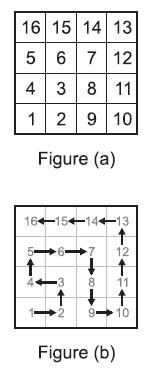Pro.ID22255 TitleWalk Like an Egyptian Title链接http://10.20.2.8/oj/exercise/problem?problem_id=22255 AC0 Submit0 Ratio- 时间&空间限制描述 Walk Like an Egyptian is an old multi-player board game played by children of the Sahara nomad tribes. Back in the old days, children would collect stones, and number each one of them. A game with N players requires N2 stones. Each player chooses N stones. The stones are then laid out on an N × N grid in a peculiar order as in Figure (a) (for N = 4.) The player whose stone is placed in the top-right corner loses the round. Another round is then played but with N − 1 players. In total, N − 1 rounds are played to determine the winner. Walk Like an Egyptian is an old multi-player board game played by children of the Sahara nomad tribes. Back in the old days, children would collect stones, and number each one of them. A game with N players requires N2 stones. Each player chooses N stones. The stones are then laid out on an N × N grid in a peculiar order as in Figure (a) (for N = 4.) The player whose stone is placed in the top-right corner loses the round. Another round is then played but with N − 1 players. In total, N − 1 rounds are played to determine the winner.There is a story why the stones are arranged in this order. It is said that back in the days of the Pharaohs, when entering a dark room in a Pyramid, workers would use the following “algorithm” to be able to walk in the room without losing anybody: (see Figure (b)). 1. The first worker stands in the lower-left corner of the room. 2. The next three workers stand around the first forming a quarter of a circle by going in an anti-clockwise direction. 3. The next five workers stand around the last three, again forming a quarter of a circle but this time going in a clockwise direction. 4. The workers keep repeating the last two steps until the room is filled with workers. Each time they hit the left or bottom walls, they start a larger quarter circle and alternate their direction between clockwise and anti-clockwise. Write a program that determines the stone placed on the top-right corner. 输入Your program will be tested on one or more test cases. Each test case is specified on a separate input line. Each test case will specify the number of players N where 0 < N < 1, 000. The end of the test cases is indicated by a line made of a single zero. 输出Description  Walk Like an Egyptian is an old multi-player board game played by children of the Sahara nomad tribes. Back in the old days, children would collect stones, and number each one of them. A game with N players requires N2 stones. Each player chooses N stones. The stones are then laid out on an N × N grid in a peculiar order as in Figure (a) (for N = 4.) The player whose stone is placed in the top-right corner loses the round. Another round is then played but with N − 1 players. In total, N − 1 rounds are played to determine the winner. Walk Like an Egyptian is an old multi-player board game played by children of the Sahara nomad tribes. Back in the old days, children would collect stones, and number each one of them. A game with N players requires N2 stones. Each player chooses N stones. The stones are then laid out on an N × N grid in a peculiar order as in Figure (a) (for N = 4.) The player whose stone is placed in the top-right corner loses the round. Another round is then played but with N − 1 players. In total, N − 1 rounds are played to determine the winner.There is a story why the stones are arranged in this order. It is said that back in the days of the Pharaohs, when entering a dark room in a Pyramid, workers would use the following “algorithm” to be able to walk in the room without losing anybody: (see Figure (b)). 1. The first worker stands in the lower-left corner of the room. 2. The next three workers stand around the first forming a quarter of a circle by going in an anti-clockwise direction. 3. The next five workers stand around the last three, again forming a quarter of a circle but this time going in a clockwise direction. 4. The workers keep repeating the last two steps until the room is filled with workers. Each time they hit the left or bottom walls, they start a larger quarter circle and alternate their direction between clockwise and anti-clockwise. Write a program that determines the stone placed on the top-right corner. Input Your program will be tested on one or more test cases. Each test case is specified on a separate input line. Each test case will specify the number of players N where 0 < N < 1, 000. The end of the test cases is indicated by a line made of a single zero. Output For each test case, output the result on a single line using the following format: N => result Where N is the number of players for the this test case, and result is the number on the stone placed at the top-right corner of the grid. Sample Input 4 2 0 Sample Output 4 => 13 2 => 3 Source 样例输入4 2 0 样例输出4 => 13 2 => 3 作者 |